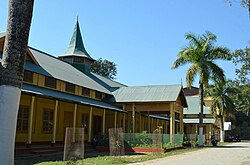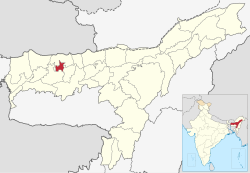Bajali district is a district of the Indian state of Assam, carved out of Barpeta district.[1] The Assam Cabinet headed by former Chief Minister Sarbananda Sonowal approved the proposal to make Bajali a full-fledged district on 10 August 2020.[2] On 12 January 2021 Bajali was formally declared as a district.[3] On 31 December 2022, the district was remerged with existing Barpeta district.[4]
Bajali district | |
|---|---|
 Bajali college | |
 Location in Assam | |
| Country | |
| State | Assam |
| Division | Lower Assam |
| Established | 12 January 2021 |
| Headquarters | Pathsala |
| Government | |
| • Lok Sabha constituencies | Kokrajhar, Barpeta |
| Area | |
| • Total | 418 km2 (161 sq mi) |
| Population (2011) | |
| • Total | 253,816 |
| • Density | 610/km2 (1,600/sq mi) |
| Website | https://bajali.assam.gov.in/ |
However, on August 25, 2023, the Assam cabinet made an announcement regarding the restoration of the district status of Bajali[5] and on October 12, Bajali again became a district.[6]
Bajali comprised parts of Bajali, Jalah and Sarupeta circles. Dolor Pathar is the most popular village under bajali district And Pathsala is main town of the district.
Demographics
According to the 2011 census, erstwhile Bajali district has a population of 253,876, of which 11,242 (4.43%) live in urban areas. Bajali has a sex ratio of 978 females per 1000 males. Scheduled Castes notably the Kaibarta-Jalkeot community and Scheduled Tribes notably the Boro community make up 19,192 (7.56%) and 11,486 (4.52%) of the population respectively.[8]
| Circle | Hindus (%) | Muslims (%) | Others (%) |
|---|---|---|---|
| Bajali (Pt) | 94.51 | 5.34 | 0.15 |
| Sarupeta (Pt) | 43.89 | 55.92 | 0.19 |
| Jalah (Pt) | 86.32 | 13.54 | 0.14 |
The district religious composition are as follows: Hindu 172,388, Muslim 81,003 and others at 485 as per 2011 census report.[7]
189,075 of the population spoke Assamese, 53,052 Bengali, 10,877 Boro and 0.36% speaks other minority languages.[9]
